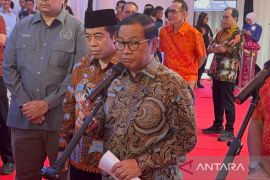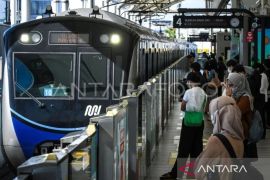He went all the way from the comfort of his home in the Cibubur area, East Jakarta, fighting the infamous, unforgiving density of the capital city's traffic, to check the 'well-being' of his motorbike.
Although the Jakarta Administration-owned workshop opened at 8 a.m. local time, he was already queuing with dozens of other bikers to get a free service for motor vehicle emission tests.
At that time, there were already around 50 people queuing for the service offered by the shop that is open every Tuesday and Thursday.
Related news: Jakarta air quality in 2020 better than in 2019: ministry
"I just follow the rules so I won't get a ticket later. We will feel relieved if the emission vehicle remains (at) safe (level)," Handoko said.
For the test vehicle emissions, people only need to show their Vehicle Registration Certificates (STNK) to the workshop.
The service is not limited to vehicles with Jakarta registration mark, but also vehicles from cities outside Jakarta.
In the workshop of the Jakarta Environment Office, there are three emission testing areas, namely two tools for testing the emissions of two-wheeled vehicles and one each for testing the emissions of gasoline and diesel cars.
Related news: Jakarta governor orders inspection of industrial chimneys
For testing motorcycles, some six motorcycles are tested during each interval. As for four-wheeled vehicles, they can test two to three cars at once. Each emission check takes up about five minutes for one vehicle.
After the test is completed, the driver will get an emission test card which contains data on motorized vehicles to information on emission test results and thresholds.
The carbon monoxide (CO) threshold for motorized vehicles is 5.5 percent and for hydrocarbons (HC) 2,400 parts per million (ppm).
If the vehicle does not pass the emission test, the staff will direct the driver to do vehicle maintenance and oil change.
Handoko is grateful that his motorbike is still in top condition, thereby passing the emission test.
Related news: Civil lawsuit's trial over Jakarta's air pollution scheduled today
Source of pollution
The ever growing number of motorized vehicles in Jakarta is one of the causes that contributes to traffic jams and air pollution in the capital city.
The Jakarta Central Bureau of Statistics recorded that the number of motorized vehicles in the capital city continues to increase every year.
The agency said that until 2020, the number of motorized vehicles reached 20.2 million units. Motorcycles make up almost 80 percent of the total number, or 16.1 million units.
The rest are passenger cars, amounting 3.36 million units and trucks 680 thousand units.
One can only imagine the impact of human activities on air quality if these vehicles have not undergone the emission test or do not pass the emission tests.
The increase in the number and types of motorized vehicles causes an increase in the number of emissions released in the form of carbon monoxide (CO), hydrocarbons (HC), nitric gas (NO) and dust.
According to the calculation of air pollution emissions conducted by the Jakarta Environment Office, in collaboration with Vital Strategies, the largest source of pollution in the capital city is motor vehicles with pollutants in the form of particulate matter (PM) 2.5, nitrogen oxides (NOx) and CO .
The study conducted in 2020 aimed to measure the largest emission contributors in Jakarta as a basis for policy-making in relation to air pollution in the capital city.
Related news: Jakarta should use electric cars to improve air quality: Jokowi
It was found that the transportation means are the main source of air pollution, particularly for producing pollutants such as NOx, pegged at 72.40 percent, CO (96.36 percent), PM10 (57.99 percent) and PM2.5 (67.03 percent).
Meanwhile, the industry sector is the largest source of pollution for emitting sulfur dioxide (SO2) pollutants, which contributed about 61.96 percent, and is the second largest emitter of NOx (11.49 percent), PM10 (33.9 percent), and PM2.5 (26. 8 percent).
The Jakarta Environment Office also noted that the findings were consistent with several studies in 2019 conducted by Prof. Dr Puji Lestari from the Bandung Institute of Technology.
At that time, it was revealed that the transportation sector was the largest contributor to CO pollutants by 93 percent, NOx (57 percent) and PM2.5 (46 percent).
At that time, it was revealed that the transportation sector was the largest contributor to CO pollutants by 93 percent, NOx (57 percent) and PM2.5 (46 percent).
Related news: Using public transportation reduces air pollution: VP
Postponed sanction
Regulations concerning exhaust emissions are stipulated among other things in Article 48 of Law Number 22 of 2009 on Road Traffic and Transportation.
Motor vehicle exhaust emissions are one of the indicators for measuring the technical requirements, and to determine whether a vehicle is worthy of being on the road.
In regional level, the regulation is stipulated in governor's regulations.
Jakarta Governor Anies Baswedan issued Governor Regulation No. 66 of 2020 which requires motorized vehicles over three years old to undergo exhaust emission tests.
The governor's regulation was enacted on July 22, 2020 and will take effect or enforced for six months later or in early 2021.
Related news: Clean air experienced only 34 days a year in Jakarta
The Jakarta Provincial Government would sanction drivers who violate the test on November 13, 2021, either by not partaking it or not passing it, by issuing tickets.
The Head of Jakarta Transportation Office, Syafrin Liputo, pointed out that the issuance of ticketing sanction refers to Law No. 22 of 2009 regarding Road Traffic and Transportation.
Based on the provisions of Article 285 and Article 286 of the law, the maximum fine for motorbikes is Rp. 250,000 (around USD 17.5), while the maximum fine for cars is Rp. 500,000 (almost USD 35).
This ticketing policy is also in line with the decision of the Central Jakarta District Court, which heard the voices and demands of residents who are members of the Capital Coalition regarding Jakarta's air pollution.
The Jakarta Provincial Government decided to impose sanctions on moving sources, those being motorized vehicles that pollute the air or do not pass the emission test.
Related news: Jakarta health office makes efforts to tackle air pollution issue
However, the implementation of the fine would be enforced gradually, by observing the rate or percentage of motorized vehicles that have been checked for its well-being to the number of emission test workshops in Jakarta.
Initially, the fine would be applied starting November 13, 2021. However, the sanction has been postponed because motor vehicles in Jakarta that have been tested for emissions are still relatively low.
Deputy Governor of Jakarta Ahmad Riza Patria highlighted that until November 6, 2021, the number of motorized vehicles in the city that have been tested for emissions was only 10 to 15 percent.
Following that, the Jakarta Regional Police has postponed the fines for vehicles that do not pass the emission test in Jakarta, starting November 13, 2021.
According to the Head of the Sub-Directorate of Law Enforcement at the Traffic Directorate of Jakarta Regional Police, Adjunct Senior Commissioner Argo Wiyono, they could not immediately impose fines because the number of vehicles that had passed the emission test was very small.
They could only enact the sanctions if there are at least 50 percent of the vehicles that have been tested for emissions.
Thus,a public awareness campaign of emission testing is crucial, before the regulation on the fines is implemented.
Related news: Pertamina supports achievement of Indonesia's carbon emissions target
Plus the motorized vehicles in Jakarta are way too many, and the number of emission test workshops in the capital city is to few in comparison to them. Many more emission test workshops are needed in the capital city.
Baswedan regulated that vehicle emission tests are conducted at emission test workshops, emission test kiosks and emission test service vehicles, in line with the the Government Regulation no. 66 of 2020.
Head of the Jakarta Environment Office Asep Kuswanto said that the administration has worked with several workshop associations and brand holder agents (APM) in providing emission test sites.
To date, there are 250 four-wheel vehicle emission test providers and 15 two-wheel vehicle emission test providers in Jakarta.
Related news: Indonesia to reiterate commitment to lowering emissions at COP26
The public can download the e-emission test application to find out the location of the emission test workshop for four-wheeled vehicles or cars.
Through the application, workshops that wish to register as a motor vehicle emission test location can also be carried out.
On the other hand, the location of the motorcycle/two-wheeled emission test can be updated via social media @dinaslhdki.
So far, only government offices offer the free motor vehicle emission test service. One of which is the Jakarta Environment Office workshop.
Related news: Indonesia can achieve net-zero emissions sooner: minister
Private workshops charge around Rp150 thousand (around USD 10.5) for cars and Rp. 50 thousand (around USD 3.5 ) for motorbikes. The test result is valid for one year.
It is expected that the imposition of this emission test policy would encourage drivers of vehicles operating in Jakarta to meet the standard threshold for exhaust gas emission quality.
As a result, exhaust gas output is expected to help improve air quality in the capital city.
Apart from improving Jakarta's air, hopefully it will also affect the health of the residents of the capital city for the better.
Related news: RI presents telecommunication technology innovations in Expo 2020
Related news: Indonesia pushes for enhanced cooperation with Thailand in tourism
Editor: Fardah Assegaf
Copyright © ANTARA 2021












